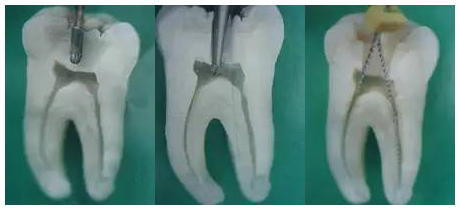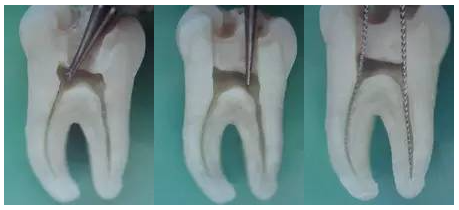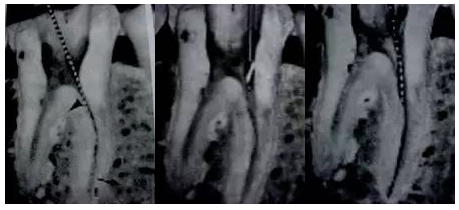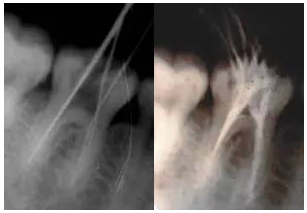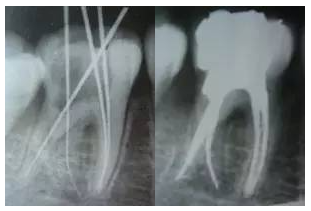1. Open pulp: whether the preparation of the hole meets the requirements, whether the roof of the pulp chamber is just right, without destroying the wall and bottom structure of the hole...
Figure 1 crack drill to the pulp Figure 2 Ball drill through the pulp Figure 3 small file root outlet
Figure 4 Ball drill uncovering the pulp top Figure 5 trim the hole type, Figure 6 completes the pulp opening
2. Corruption removal: whether to completely remove the corruption of the pit before the root canal preparation, and to avoid bringing the crown pollution into the root canal in the process of root canal preparation;
3. Straight channel of the root tube mouth: especially for the curved root tube! Whether the root canal pays attention to this link before the preparation. Although the root canal mouth is found, the file can also enter the root canal smoothly, but whether the straight channel of the root canal is established is also an important basis to measure the doctor's operation skills.
There are many methods: manual device operation we can use cheap "GG" drill, PROTAPER mobile preparation can use SX file.
FIG. 7 Preparation with a GG drill or SX file
Figure 9 for the straight channels formed after treatment
The filling effect of my case 1_ crown after treatment into a straight channel
My case 2_ mandibular 7 "C" type root canal filling effect
4. Dredge the middle and lower root tubes: use small files 08 and 10 K files for exploration. The technique is to rub the 30 degrees back and forth, establish the preparatory channel of the middle and lower sections of the root canal, and then change to 15 K files to facilitate the entry of large stainless steel instruments or nickel-titanium instruments.
5. Determine the working length: the 15 K file enters with the root tester; take X-RAY before, during and after operation.
6, flushing method: every time before the change file and all, but whether effective is often uncertain, because of the effect of flushing and various factors about —— small needle (if there is no special needle can use small needle), "double flushing method (since name)" —— namely each time after rinse with small file (such as 10 or 15) into the root canal, let the debris with the rinse liquid in the root tube, and then secondary rinse, so can remove the root debris thoroughly! Pay attention to do not remove the rinse fluid in the root canal after the first rinse, its existence has a very important role!
7, the establishment of root filling file: the junction of apical dentin and cementum do not destroy, which is very meaningful for the later root filling and the choice of the main tip, the premise is that each preparation to clearly grasp the length of the work!
8, bending root tube is best used stainless steel file with nickel titanium file: with stainless steel equipment to prepare the middle and lower section, nickel titanium equipment preparation middle and upper section!
9, "crown root direction" preparation is a desirable method, but sometimes still need to be combined with the "gradual backward method" to use.
10. Familiar with the performance of the devices and the clinical points of various operation methods:
Some problems in the gradual retreat preparation: ① The contact area between the root canal file and the root canal wall is large (the file is difficult to enter; easy to get stuck; the device is easy to break; debris is easy to be pushed to the apical area; the file tip is not easy to control.); ② Limited root canal forming (difficult to flush the apical area; difficult to remove debris; debris easy to push outside the root tip hole); ③ requires frequent file change (complicated operation; long clinical operation time). Therefore, many dentists have not used this method and instead use the "Crown Down". But stainless steel equipment (such as K file) still has its use —— small K file can be used to find root canal and root canal dredging; used to determine the working length; used for root tip preparation; bending root tube with nickel titanium equipment preparation is relatively safe!
The advantage of "Crown Down" (such as commonly used nickel titanium device PROTAPER) is that —— cutting ability reduces the operation times; to facilitate root canal filling; can effectively remove debris and avoid the root tip hole; easy to remove the crown barrier and obtain the straight channel into the root canal. The operation procedure is —— to probe the root canal, expand the crown and determine the working length, then prepare the middle section of the root canal, and finally prepare the apical area.
Finally, to play an evaluation of the quality of root canal treatment —— The following picture is a case of Professor Peng Bin of Wu University, careful observation can pick out a little problem, but the problem is due to something! Look at your "eye" how —— where is the problem? Professor's professional level is not in doubt, so what may be the reason?
Answer: The question in this case is mainly reflected in the opening of the hole shape. Pay attention to the left hole wall of the X-RAY of the tooth. If routinely prepared, the drill destroyed the hole wall and the bottom of the hole. If you evaluate the quality of root canal treatment, it will deduct points!
However, a careful observation of the shape of the hole wall in this case can be seen that this case is a retreated case, so it is still an ideal case.
 Open wechat
Open wechat